What's inside
What's inside
 Key Ingredients
Key Ingredients

 Benefits
Benefits

 Concerns
Concerns

 Ingredients Side-by-side
Ingredients Side-by-side

Water
Skin ConditioningAcrylates Copolymer
Copernicia Cerifera Wax
Paraffin
PerfumingPentylene Glycol
Skin ConditioningPolyvinyl Alcohol
Stearic Acid
CleansingPolysorbate 80
EmulsifyingCI 77499
Cosmetic ColorantPalmitic Acid
EmollientAcacia Senegal Gum
MaskingSynthetic Beeswax
Emulsion StabilisingSynthetic Wax
AbrasiveCI 77491
Cosmetic ColorantCetearyl Alcohol
EmollientButylene Glycol
HumectantTromethamine
BufferingCI 77492
Cosmetic ColorantGlyceryl Stearate
EmollientPhenoxyethanol
PreservativeCI 77007
Cosmetic ColorantHydroxyethylcellulose
Emulsion StabilisingEthylhexylglycerin
Skin ConditioningDisodium EDTA
Polysorbate 60
EmulsifyingDisodium Phosphate
BufferingSodium Phosphate
BufferingWater, Acrylates Copolymer, Copernicia Cerifera Wax, Paraffin, Pentylene Glycol, Polyvinyl Alcohol, Stearic Acid, Polysorbate 80, CI 77499, Palmitic Acid, Acacia Senegal Gum, Synthetic Beeswax, Synthetic Wax, CI 77491, Cetearyl Alcohol, Butylene Glycol, Tromethamine, CI 77492, Glyceryl Stearate, Phenoxyethanol, CI 77007, Hydroxyethylcellulose, Ethylhexylglycerin, Disodium EDTA, Polysorbate 60, Disodium Phosphate, Sodium Phosphate
Water
Skin ConditioningAmmonium Acrylates Copolymer
Copernicia Cerifera Cera
EmollientGlyceryl Stearate Se
EmulsifyingCandelilla Cera
EmollientSucrose Stearate
EmollientGlyceryl Stearate
EmollientVp/Hexadecene Copolymer
Propanediol
SolventC10-18 Triglycerides
EmollientLecithin
EmollientPolybutene
Cera Microcristallina
Emulsion StabilisingHydrogenated Vegetable Oil
EmollientOleic Acid
EmollientAlcohol Denat.
AntimicrobialStearic Acid
CleansingArginine
MaskingCaesalpinia Spinosa Gum
Skin ConditioningStearyl Stearate
EmollientBenzyl Alcohol
PerfumingCaprylyl Glycol
EmollientDisodium Deceth-6 Sulfosuccinate
CleansingPanthenol
Skin ConditioningSimethicone
EmollientLaureth-30
CleansingSodium Dehydroacetate
PreservativeTrisodium Ethylenediamine Disuccinate
Glycerin
HumectantCeramide Ng
Skin ConditioningAcacia Senegal Gum
MaskingCI 77491
Cosmetic ColorantCI 77492
Cosmetic ColorantCI 77499
Cosmetic ColorantCI 77007
Cosmetic ColorantWater, Ammonium Acrylates Copolymer, Copernicia Cerifera Cera, Glyceryl Stearate Se, Candelilla Cera, Sucrose Stearate, Glyceryl Stearate, Vp/Hexadecene Copolymer, Propanediol, C10-18 Triglycerides, Lecithin, Polybutene, Cera Microcristallina, Hydrogenated Vegetable Oil, Oleic Acid, Alcohol Denat., Stearic Acid, Arginine, Caesalpinia Spinosa Gum, Stearyl Stearate, Benzyl Alcohol, Caprylyl Glycol, Disodium Deceth-6 Sulfosuccinate, Panthenol, Simethicone, Laureth-30, Sodium Dehydroacetate, Trisodium Ethylenediamine Disuccinate, Glycerin, Ceramide Ng, Acacia Senegal Gum, CI 77491, CI 77492, CI 77499, CI 77007
Ingredients Explained
These ingredients are found in both products.
Ingredients higher up in an ingredient list are typically present in a larger amount.
Acacia Senegal Gum has skin soothing, thickening, and formulation stabilizing properties. It comes from the Acacia tree that is native to sub-Saharan Africa.
This pigment is called Ultramarine blue lazurite. It gives a saturated blue color, but can be used to create other colors as well.
According to the manufacturer, it is usually made from kaolin, sodium sulfate, sodium carbonate, sulfur, and charcoal.
Ci 77491 is also hydrated iron III oxide. It's sole purpose is to give a red/pink hue to products.
Iron III oxides are classified as inorganic chemicals for coloring.
Synthetically created Ci 77491 is considered safer than those naturally found. This is because the synthetically created version may contain less impurities. Iron oxides are generally non-toxic and non-allergenic.
Learn more about CI 77491Ci 77492 is also hydrated iron III oxide. It's sole purpose is to give a yellow hue to products.
Iron III oxides are classified as inorganic chemicals for coloring.
Synthetically created Ci 77492 is considered safer than those naturally found. This is because the synthetically created version may contain less impurities. Iron oxides are generally non-toxic and non-allergenic.
Learn more about CI 77492Ci 77499 is also hydrated iron III oxide. It is created from mixing red and black iron oxides. This helps give shades of darkness to a product.
Iron III oxides are classified as inorganic chemicals for coloring.
Glyceryl Stearate is a mix of glycerin and stearic acid.
It is used to stabilize the mixing of water and oil ingredients. By preventing these ingredients from separating, it can help elongate shelf life. It can also help thicken the product's texture.
As an emollient, it helps soften skin and supports barrier-replenishing ingredients.
In cosmetics, Glyceryl Stearate is often made from vegetable oils or synthetically produced.
This ingredient may not be fungal-acne safe
Fun fact: The human body also creates Glyceryl Stearate naturally.
Learn more about Glyceryl StearateStearic Acid is a fatty acid. It is an emollient, emulsifier, and texture enhancer.
As an emollient, stearic acid helps soften skin. It aids the skin's protective barrier by preventing water loss. It also provides a gentle cleansing effect without stripping away natural oils.
Stearic acid may also be used to enhance the texture of products. It can add volume and stabilize ingredients such as water and oil. This can help water and oil ingredients from separating.
Sources of stearic acid include animal or vegetable fats/oils such as coconut or shea. It can be naturally found in butter, cocoa butter, shea butter, vegetable fats, and animal tallow.
This ingredient may not be Malassezia folliculitis, or fungal-acne safe.
Learn more about Stearic AcidWater. It's the most common cosmetic ingredient of all. You'll usually see it at the top of ingredient lists, meaning that it makes up the largest part of the product.
So why is it so popular? Water most often acts as a solvent - this means that it helps dissolve other ingredients into the formulation.
You'll also recognize water as that liquid we all need to stay alive. If you see this, drink a glass of water. Stay hydrated!
Learn more about Water